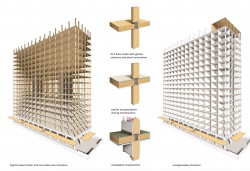The heights that solid timber construction is reaching grow each year. A new development at the University of British Columbia (UBC) in Vancouver, Canada is set to amongst the world’s tallest.
When complete in 2017, the $51.5-million, 18-storey (53m) Brock Commons, will house hundreds of students at the University of British Columbia (UBC).
Earlier this year, the British Columbia (B.C) government passed the provincial Building Act, which enables innovation in building construction. The Building Act enabled the Province to develop a regulation to allow construction of UBC’s new tall wood student residence, with rigorous health and safety standards.
“This beautiful, new tall wood building will serve as a living laboratory for the UBC community,” said Martha Piper, interim president. “It will advance the university’s reputation as a hub of sustainable and innovative design, and provide our students with much-needed on-campus housing.”
The 18-storey tower will house 404 students in 272 studios and 33 four-bedroom units, and feature study and social gathering spaces. There will also be a ground-floor lounge and study space for commuter students.
“This project shows that when it comes to building with wood, B.C.’s innovation can’t be beat,” said Steve Thomson, minister of Forests, Lands and Natural Resource Operations. “By taking advantage of new building technologies, we’re also expanding our markets for B.C. wood products – and supporting jobs in the forest sector.”
In addition to its primary function as a student residence, the building will serve as an academic site for students and researchers, who will be able to study and monitor its operations.
The tall wood building will consist of a mass timber superstructure atop a concrete base. UBC aims for the building to achieve a minimum LEED Gold certification, a rating system that evaluates how environmentally friendly a structure is in its design and energy use.
UBC’s Student Housing and Hospitality Services, the Binational Softwood Lumber Council, Forestry Innovation Investment, Natural Resources Canada and B.C.’s Ministry of Forests, Lands and Natural Resource Operations are contributing funding for the building. Any additional costs related to design and construction has been funded through external sources. Students will pay the same for rent at the tall wood building compared to similar accommodations at other student residences on campus.
UBC Properties Trust is managing the project. The project’s architect, Vancouver’s Acton Ostry Architects, is working in collaboration with tall wood advisor Architekten Hermann Kaufmann from Austria. Fast + Epp, another local firm, is the structural engineer.
Other wood structure buildings on UBC’s Vancouver campus include the new AMS Student Nest and Engineering Student Centre, the Centre for Interactive Research on Sustainability, the Bioenergy Research and Demonstration Facility, and the Earth Sciences Building.
“When we introduced B.C.’s Building Act this year, one of our goals was to encourage innovation by creating an approval process for groundbreaking projects like this one,” said Rich Coleman, minister of natural gas development and minister responsible for housing. “As a result, we have been able to approve UBC’s tall wood building, while ensuring it meets rigorous health and safety standards.”
“We’re thrilled to partner with UBC on this exciting project,” said Cees de Jager, general manager of the Binational Softwood Lumber Council. “The residence is a showcase of innovation and ingenuity that will contribute greatly to transforming how we develop taller wood buildings in the future. Lessons learned at UBC will stimulate increased use of wood throughout North America and beyond, benefiting our industry, our communities and our environment.”
The UBC student residence is a winning project as part of an Expression of Interest (EOI) launched by the Canadian Wood Council in April 2013, for Canadian developers, institutions, organisations and design teams willing to undertake an innovative approach to designing and building high-rise demonstration projects. With funding support from the Binational Softwood Lumber Council, the goal of this initiative was to link new scientific advances and data with technical expertise to showcase the application, practicality and sustainability of innovative wood based structural building solutions.
“The Canadian Wood Council congratulates UBC on its commitment to build a tall wood students’ residence,” said Michael Giroux, president of the Canadian Wood Council. “We are entering an exciting time for the Canadian and North American wood products industry. As the tallest wood building in Canada, this project will serve as a great example of the research and technology that is involved in taking wood construction to new heights – resulting in innovative solutions that are safe, sustainable and viable, and meet or exceed the requirements of the building code.”
FPInnovations, a forest sector research centre, conducted tests on the UBC building’s wood structural components. The building’s safety measures include enhanced fire protections and back-up systems, a building-monitoring system and an upgraded building core, the first in B.C. to be specified to the new 2015 National Building Code of Canada for seismic design.
A number of tall wood projects have been completed around the world in recent years. Today, the concept is gaining traction in North America as a safe, sustainable and cost-effective construction option.
The world’s current tallest wood building is a 32-metre (105-foot), 10-storey apartment building in Melbourne, Australia. Prince George’s Wood Innovation and Design Centre, completed in October 2014, is the tallest wood building in North America, standing at 29.5 metres (97 feet). A 51-metre (167-foot), 14-storey apartment building is now under construction in Norway. Two other tall wood projects have been announced for New York and Portland.
Source: ST Magazine









